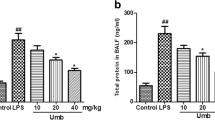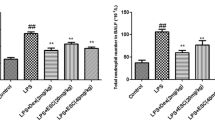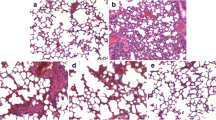Abstract
IFN-τ, which is a type I interferon with low cytotoxicity, is defined as a pregnancy recognition signal in ruminants. Type I interferons have been used as anti-inflammatory agents, but their side effects limit their clinical application. The present study aimed to determine the anti-inflammatory effects of IFN-τ in a lipopolysaccharide-stimulated acute lung injury (ALI) model and in RAW264.7 cells and to confirm the mechanism of action involved. The methods used included histopathology, measuring the lung wet/dry ratio, determining the myeloperoxidase activity, ELISA, qPCR, and western blot. The results revealed that IFN-τ greatly ameliorated the infiltration of inflammatory cells and the expression of TNF-α, IL-1β, and IL-6. Further analysis revealed that IFN-τ down-regulated the expression of TLR-2 and TLR-4 mRNA and the activity of the NF-κB and MAPK pathways both in a lipopolysaccharide-induced ALI model and in RAW264.7 cells. The results demonstrated that IFN-τ suppressed the levels of pro-inflammatory cytokines by inhibiting the phosphorylation of the NF-κB and MAPK pathways. Thus, IFN-τ may be an optimal target for the treatment of inflammatory diseases.






Similar content being viewed by others
References
Saugandhika, S., V. Sharma, H. Malik, et al. 2015. Expression and purification of buffalo interferon-tau and efficacy of recombinant buffalo interferon-tau for in vitro embryo development. Cytokine 75: 186–196.
Chethan, S.G., S.K. Singh, J. Nongsiej, et al. 2014. IFN-tau acts in a dose-dependent manner on prostaglandin production by buffalo endometrial stromal cells cultured in vitro. Reproduction in Domestic Animals 49: 403–408.
LeMessurier, K.S., H. Hacker, L. Chi, E. Tuomanen, and V. Redecke. 2013. Type I interferon protects against pneumococcal invasive disease by inhibiting bacterial transmigration across the lung. PLoS Pathogens 9, e1003727.
Gough, D.J., N.L. Messina, C.J.P. Clarke, R.W. Johnstone, and D.E. Levy. 2012. Constitutive Type I interferon modulates homeostatic balance through tonic signaling. Immunity 36: 166–174.
Cho, H., and B.L. Kelsall. 2014. The role of type I interferons in intestinal infection, homeostasis, and inflammation. Immunology Reviews 260: 145–167.
Bartol, F.F., R.M. Roberts, F.W. Bazer, G.S. Lewis, J.D. Godkin, and W.W. Thatcher. 1985. Characterization of proteins produced in vitro by periattachment bovine conceptuses. Biology of Reproduction 32: 681–693.
Alexenko, A.P., A.D. Ealy, and R.M. Roberts. 1999. The cross-species antiviral activities of different IFN-tau subtypes on bovine, murine, and human cells: contradictory evidence for therapeutic potential. Journal of Interferon & Cytokine Research 19: 1335–1341.
Bazer, F.W., J. Kim, G. Song, H. Ka, C.D. Tekwe, and G. Wu. 2012. Select nutrients, progesterone, and interferon tau affect conceptus metabolism and development. Annals of the New York Academy of Sciences 1271: 88–96.
Ying, W., S. Kanameni, C.A. Chang, V. Nair, S. Safe, F.W. Bazer, and B.Y. Zhou. 2014. Interferon tau alleviates obesity-induced adipose tissue inflammation and insulin resistance by regulating macrophage polarization. PloS One 9: 1–17.
Hara, K., K. Shirasuna, F. Usui, et al. 2014. Interferon-tau attenuates uptake of nanoparticles and secretion of interleukin-1beta in macrophages. PloS One 9, e113974.
Zhang, S.Y., L.T. Xu, A.X. Li, and S.M. Wang. 2015. Effects of ergosterol, isolated from scleroderma polyrhizum pers., on lipopolysaccharide-induced inflammatory responses in acute lung injury. Inflammation 38: 1979–1985.
Conti, G., S. Tambalo, G. Villetti, et al. 2010. Evaluation of lung inflammation induced by intratracheal administration of LPS in mice: comparison between MRI and histology. Magnetic Resonance Materials in Physics 23: 93–101.
Wang, Y., Q. Tu, W. Yan, et al. 2015. CXC195 suppresses proliferation and inflammatory response in LPS-induced human hepatocellular carcinoma cells via regulating TLR4-MyD88-TAK1-mediated NF-kappaB and MAPK pathway. Biochemical and Biophysical Research Communications 456: 373–379.
Damjanovic, D., A. Khera, M.F. Medina, et al. 2014. Type 1 interferon gene transfer enhances host defense against pulmonary Streptococcus pneumoniae infection via activating innate leukocytes. Molecular Therapy Methods & Clinical Development 1(5): 1–11.
Chon, T.W., and S. Bixler. 2010. Interferon-tau: current applications and potential in antiviral therapy. Journal of Interferon & Cytokine Research 30: 477–485.
Soos, J.M., P.S. Subramaniam, A.C. Hobeika, J. Schiffenbauer, and H.M. Johnson. 1995. The IFN pregnancy recognition hormone IFN-tau blocks both development and superantigen reactivation of experimental allergic encephalomyelitis without associated toxicity. Journal of Immunology 155: 2747–2753.
Do-Umehara, H.C., C. Chen, D. Urich, et al. 2013. Suppression of inflammation and acute lung injury by Miz1 via repression of C/EBP-delta. Nature Immunology 14: 461–469.
Kim, Y.J., J.H. Kim, K.J. Lee, et al. 2015. Botulinum neurotoxin type A induces TLR2-mediated inflammatory responses in macrophages. PloS One 10, e0120840.
Xu, X., P. Yin, C. Wan, et al. 2014. Punicalagin inhibits inflammation in LPS-induced RAW264.7 macrophages via the suppression of TLR4-mediated MAPKs and NF-kappaB activation. Inflammation 37: 956–965.
Tao, W.W., Q. Su, H.Q. Wang, et al. 2015. Platycodin D attenuates acute lung injury by suppressing apoptosis and inflammation in vivo and in vitro. International Immunopharmacology 27: 138–147.
Roberts, R.M., A.D. Ealy, A.P. Alexenko, C.S. Han, and T. Ezashi. 1999. Trophoblast interferons. Placenta 20: 259–264.
Roberts, R.M. 2007. Interferon-tau, a Type 1 interferon involved in maternal recognition of pregnancy. Cytokine & Growth Factor 18: 403–408.
Li, D., Y. Fu, W. Zhang, et al. 2013. Salidroside attenuates inflammatory responses by suppressing nuclear factor-kappaB and mitogen activated protein kinases activation in lipopolysaccharide-induced mastitis in mice. Inflammation Research 62: 9–15.
Gonzalez-Navajas, J.M., J. Lee, M. David, and E. Raz. 2012. Immunomodulatory functions of type I interferons. Nature Reviews Immunology 12: 125–135.
Yan, B., S. Ye, G. Chen, M. Kuang, N. Shen, and S. Chen. 2008. Dysfunctional CD4+, CD25+ regulatory T cells in untreated active systemic lupus erythematosus secondary to interferon-alpha-producing antigen-presenting cells. Arthritis and Rheumatism 58: 801–812.
Namdar, A., B. Nikbin, M. Ghabaee, A. Bayati, and M. Izad. 2010. Effect of IFN-beta therapy on the frequency and function of CD4(+)CD25(+) regulatory T cells and Foxp3 gene expression in relapsing-remitting multiple sclerosis (RRMS): a preliminary study. Journal of Neuroimmunology 218: 120–124.
Sleijfer, S., M. Bannink, A.R. VanGool, W.H.J. Kruit, and G. Stoter. 2005. Side effects of interferon-alpha therapy. Pharmacy World and Science 27: 423–431.
Trinchieri, G. 2010. Type I interferon: friend or foe? The Journal of Experimental Medicine 207: 2053–2063.
Chen, X., J.S. Miao, H. Wang, et al. 2015. The anti-inflammatory activities of Ainsliaea fragrans Champ. extract and its components in lipopolysaccharide-stimulated RAW264.7 macrophages through inhibition of NF-kappa B pathway. Journal of Ethnopharmacology 170: 72–80.
Rauch, I., M. Muller, and T. Decker. 2013. The regulation of inflammation by interferons and their STATs. JAK-STAT 2, e23820.
Wang, J., Y.T. Liu, L. Xiao, L. Zhu, Q. Wang, and T. Yan. 2014. Anti-inflammatory effects of apigenin in lipopolysaccharide-induced inflammatory in acute lung injury by suppressing COX-2 and NF-kB pathway. Inflammation 37: 2085–2090.
Seifart, C., A. Dempfle, A. Plagens, et al. 2005. TNF-alpha-, TNF-beta-, IL-6-, and IL-10-promoter polymorphisms in patients with chronic obstructive pulmonary disease. Tissue Antigens 65: 93–100.
Xu, D., M. Chen, X. Ren, X. Ren, and Y. Wu. 2014. Leonurine ameliorates LPS-induced acute kidney injury via suppressing ROS-mediated NF-kappaB signaling pathway. Fitoterapia 97: 148–155.
Cao, W.J., W. Zhang, J.J. Liu, et al. 2011. Paeoniflorin improves survival in LPS-challenged mice through the suppression of TNF-alpha and IL-1 beta release and augmentation of IL-10 production. International Immunopharmacology 11: 172–178.
Hopkins, S.J. 2003. The pathophysiological role of cytokines. Legal Medicine 5(Suppl 1): S45–S57.
Wang, G., B. Sun, Y. Gao, Q.H. Meng, and H.C. Jiang. 2007. The effect of emodin-assisted early enteral nutrition on severe acute pancreatitis and secondary hepatic injury. Mediators of Inflammation 2007: 29638.
Noreen, M., and M. Arshad. 2015. Association of TLR1, TLR2, TLR4, TLR6, and TIRAP polymorphisms with disease susceptibility. Immunologic Research 62: 234–252.
Takeuchi, O., K. Hoshino, T. Kawai, et al. 1999. Differential roles of TLR2 and TLR4 in recognition of gram-negative and gram-positive bacterial cell wall components. Immunity 11: 443–451.
Xiang, P., T. Chen, Y. Mou, et al. 2015. NZ suppresses TLR4/NF-kappaB signalings and NLRP3 inflammasome activation in LPS-induced RAW264.7 macrophages. Inflammation Research 64: 799–808.
Yamamoto, Y., and R.B. Gaynor. 2004. IkappaB kinases: key regulators of the NF-kappaB pathway. Trends in Biochemical Sciences 29: 72–79.
Ren, J., and S.H. Chung. 2007. Anti-inflammatory effect of alpha-linolenic acid and its mode of action through the inhibition of nitric oxide production and inducible nitric oxide synthase gene expression via NF-kappaB and mitogen-activated protein kinase pathways. Journal of Agricultural and Food Chemistry 55: 5073–5080.
Acknowledgments
This study was supported by the National Natural Science Foundation of China (NO.31272631, 31472254).
Author information
Authors and Affiliations
Corresponding author
Ethics declarations
Conflict of Interest
The authors declare that they have no competing interests.
Additional information
Haichong Wu and Gan Zhao contributed equally to this work.
Rights and permissions
About this article
Cite this article
Wu, H., Zhao, G., Jiang, K. et al. IFN-τ Alleviates Lipopolysaccharide-Induced Inflammation by Suppressing NF-κB and MAPKs Pathway Activation in Mice. Inflammation 39, 1141–1150 (2016). https://doi.org/10.1007/s10753-016-0348-9
Published:
Issue Date:
DOI: https://doi.org/10.1007/s10753-016-0348-9




